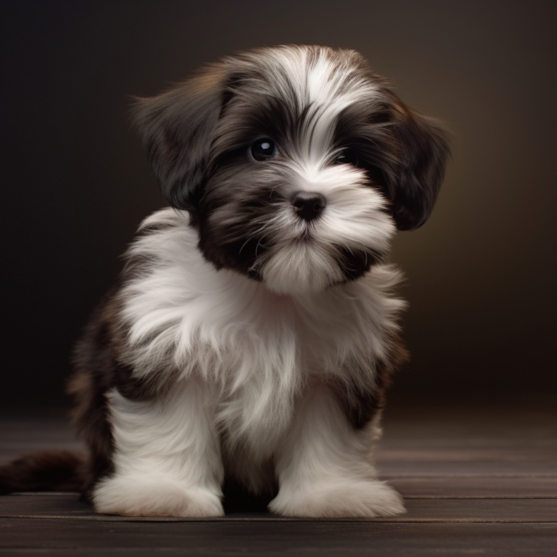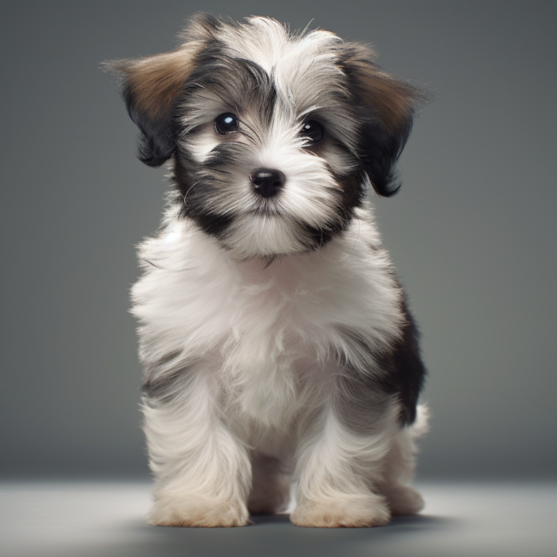Havashu Breed Information


The Havashu is a small, affectionate hybrid that brings together the steady charm of the Havanese with the sweet, spirited nature of the Shih Tzu. This companion breed was developed for closeness and connection, blending two people-focused dogs into one soft, friendly, and adaptable companion. Whether they’re snuggled up in your lap or trotting behind you through the house, Havashus stay close and tuned in.
Their size makes them ideal for apartments, small homes, or any setting where space is limited. Most fall in the 8 to 15 pound range, with a compact frame and soft coat that adds to their inviting presence. They’re comfortable with a slow, steady pace but also enjoy bursts of play, especially when their people are involved.
The Havashu temperament is one of gentle loyalty. These dogs thrive in homes where they’re part of the daily rhythm and rarely left alone for long. They’re good with kids, friendly with visitors, and easy to live with—even for first-time dog owners. Their coat may take some care, but their personality makes every bit of it worth the effort.
Characteristics
- Affectionate and people-centered – Havashus form close bonds with their families and like to stay involved. They thrive on companionship and feel most at ease when they’re part of the daily flow.
- Gentle and friendly – Their warm, welcoming nature makes them a good fit for homes with children, guests, and other pets. They approach new situations with curiosity and calm energy.
- Compact and easy to manage – Most Havashus weigh between 8 and 15 pounds, making them easy to carry, groom, and travel with. Their size fits well in both small and larger living spaces.
- Low-shedding with a soft coat – Their hair grows long and silky, sometimes with a gentle wave. They don’t shed much, but regular grooming keeps the coat comfortable and clean.
- Moderate energy level – Havashus enjoy walks, toys, and gentle play but also know how to settle down. They match the pace of the home and rarely demand more than what you can give.
- Naturally social – They’re typically happy around visitors and friendly with other dogs. Early socialization helps them stay confident, but their default setting leans toward kindness.
- Emotionally tuned-in – Havashus are sensitive to tone and mood. They tend to notice when something feels different and often respond with quiet presence and affection.
- Adaptable to different routines – This breed does well with families, singles, or seniors. Whether the home is calm or a bit lively, they adjust and stay close.
- Intelligent and easy to train – While not overly driven, Havashus learn quickly when training is gentle, consistent, and full of positive reinforcement.

Appearance
The Havashu is a small, well-proportioned dog with a soft, expressive look and a coat that gives them a gentle, inviting presence. As a mix between the Havanese and the Shih Tzu, they inherit traits from both sides, creating a dog that’s balanced in size, charming in personality, and full of visual appeal.
Most Havashus fall within the 8 to 15 pound range and stand about 9 to 12 inches tall at the shoulder. Their frame is compact but sturdy, with a body that’s slightly longer than it is tall. They move with light steps and carry themselves with a friendly, easy confidence.
The coat is one of the Havashu’s most noticeable features. It’s usually long, soft, and may be straight, wavy, or lightly curled, depending on which parent they favor. While the breed is considered low-shedding, the coat grows continuously and requires regular grooming to prevent tangles and keep it healthy.
Havashus come in a wide range of colors, including white, cream, tan, black, brown, gold, or a combination of these shades. Some coats lighten as the dog matures, while others keep their color throughout adulthood. Their patterns and markings vary widely, giving each dog a unique appearance.
Eyes are round, dark, and full of expression—often giving off a gentle or slightly mischievous look. Ears are medium-length and hang close to the cheeks, often blending into the surrounding fur. The tail typically curls slightly over the back or to the side, covered in long, flowing hair that adds to the breed’s soft silhouette.
Temperament
The Havashu has a soft, cheerful personality that fits naturally into everyday life. This breed thrives on companionship and has a temperament that feels both gentle and joyful. They enjoy being near their people—following them from room to room, curling up close during quiet moments, or stepping in with playful energy when the time feels right.
Everything about the Havashu temperament leans toward balance. They’re social without being overwhelming, alert without being anxious, and affectionate without being clingy. Their easygoing nature makes them a great match for a wide range of households—from singles and seniors to families with children.
They’re naturally warm around strangers and other pets, especially when socialized early. Havashus tend to welcome new people with soft curiosity rather than caution, which makes them an ideal family-friendly dog. Their size and patience help them get along well with kids, especially in homes where interaction stays gentle.
Emotionally, they’re very tuned in. They notice changes in tone or routine and respond with quiet understanding. Many owners describe their Havashu’s personality as comforting and steady—always nearby, never demanding, and always ready for affection or a bit of attention.
While they enjoy play and activity, they’re not high-strung or overly energetic. They tend to mirror the energy of the household. In busier moments, they’ll join in. During slower hours, they’re content to nap nearby or quietly watch from the sidelines.
The Havashu’s temperament is one of the biggest reasons they’re growing in popularity. They offer consistent companionship, emotional presence, and a friendly, welcoming attitude—exactly what most people are looking for in a small, steady dog.
Care
Grooming
The Havashu has a soft, flowing coat that adds to their charm—but keeping that coat in good shape takes regular care. While this breed is considered a low-shedding dog, its hair grows continuously and can mat easily without a consistent routine. Havashu grooming is manageable, but it does require a bit of time and attention.
Most Havashus need brushing three to five times a week to keep their coat smooth and free of tangles. A pin brush or slicker brush works well, especially for reaching the longer sections of fur around the ears, under the legs, and along the chest—areas where mats tend to form if left unchecked.
Bathing is typically needed every three to four weeks, depending on the dog’s lifestyle and coat texture. A gentle, dog-safe shampoo helps keep the skin healthy and the coat soft. After each bath, it’s important to brush the coat again while it’s drying to prevent knots and keep the hair from clumping together.
Many owners opt for professional grooming every six to eight weeks, especially if they prefer to keep the coat trimmed in a puppy cut or similar style. A regular trim keeps the coat at a manageable length, reduces maintenance time, and helps maintain that tidy, well-kept look that suits the breed’s soft features.
Ear care is another part of the routine. Since Havashus have drop ears with long hair, the area can trap moisture. Weekly checks and gentle cleaning help prevent irritation and reduce the chance of infection.
Dental care is also important. Like many small breeds, Havashus can be prone to plaque and gum sensitivity. Brushing their teeth several times a week and offering dental chews or rinses can go a long way in supporting long-term oral health.
Lastly, nail trimming should be done about once a month, or whenever the nails start to click on hard floors. Keeping their nails short helps with balance and prevents discomfort while walking.
Exercise Needs
The Havashu may be small, but they’re packed with personality and enjoy staying active in short, fun bursts. This is a breed that thrives on interaction more than intense activity. You won’t need to carve out hours for exercise, but you will want to make space in your day for movement, games, and time spent together.
Most Havashus stay balanced with 30 to 45 minutes of daily activity, broken up into light walks, play sessions, and mental stimulation. They’re quick to get the zoomies around the living room and just as quick to curl up for a nap when the energy settles.
Their size makes them well-suited for apartment living, and they don’t require a yard—but they do need daily engagement. A short walk around the block, a game of tug, or a few rounds of fetch indoors often does the trick. What matters most is consistency and variety—not distance or intensity.
Because of their smart and social nature, mental stimulation goes hand-in-hand with physical activity. Puzzle toys, hide-and-seek games, or practicing commands keep their minds engaged and help prevent boredom-related behaviors. A Havashu that stays busy is one that stays happy.
Even on slower days, these dogs still enjoy being in the mix. They’re not the type to isolate or self-entertain for long periods. If left alone too much, they may bark or chew out of frustration. A predictable routine, plenty of attention, and a few small activities spaced throughout the day keep them emotionally grounded.
Health
The Havashu is a generally healthy breed with a long lifespan and a sturdy little frame—especially when bred responsibly and cared for with consistency. Like all dogs, they have a few areas to watch, but most Havashu health issues are minor and manageable with routine care and early attention.
Thanks to their mixed-breed background, some Havashus benefit from hybrid vigor, which can reduce the risk of certain inherited conditions.
One of the more common concerns in small breeds is dental disease. The Havashu’s small mouth can lead to crowding, tartar buildup, and gum sensitivity if not cleaned regularly. Brushing several times a week, offering dental chews, and scheduling regular cleanings with a vet helps protect long-term oral health.
Some Havashus may also be prone to allergies, which can show up as itchy skin, ear infections, or mild digestive upset. These are usually manageable with vet-recommended diets, grooming adjustments, or medication when needed.
Because their ears are floppy and covered in soft hair, ear care is important. Weekly checks and gentle cleaning help prevent moisture buildup and reduce the risk of infection—especially in warmer climates or during allergy seasons.
Keeping your Havashu at a healthy weight is also key. These dogs are small, and even a few extra pounds can put stress on their joints or lead to discomfort over time. A balanced diet, portion control, and regular movement help keep everything in check.
Lifespan
The Havashu has a relatively long lifespan, with most dogs living between 12 and 16 years. With consistent care, a healthy diet, and regular vet visits, many enjoy well over a decade of companionship—often staying lively and engaged well into their senior years.
As a cross between the Havanese and the Shih Tzu, the Havashu inherits the sturdy build and steady health of both parent breeds. When raised in a stable environment and kept at a healthy weight, this is a breed that tends to age slowly and gracefully. Their energy may soften, but their need for closeness and connection stays just as strong.
As they grow older, most Havashus transition smoothly into their senior years. Walks may get shorter, naps may grow longer, and play becomes more relaxed—but their emotional connection with their people remains steady. They continue to follow family rhythms, stay close by during quiet moments, and respond to familiar voices with that same soft presence they had as puppies.
Supporting a Havashu through this stage of life doesn’t take much—just a few gentle adjustments. Softer bedding, shorter play sessions, and more frequent checkups can go a long way. Staying ahead of small issues with early intervention helps preserve comfort and quality of life.
Their longevity isn’t just about physical health—it’s also about emotional stability. Havashus thrive when their world feels predictable, loving, and secure. They build deep bonds with their families and carry those connections with them through every stage of life.
Training
The Havashu is a bright, emotionally aware dog that generally enjoys learning—especially when training feels like a shared activity rather than a task. Their intelligence and eagerness to please make them one of the more easy to train small breeds, provided the approach is calm, consistent, and positive.
Most Havashus respond best to positive reinforcement. Praise, treats, and encouragement help build confidence and create lasting habits. They don’t need tough corrections to understand what’s expected—in fact, harsh tones can cause them to shut down or become hesitant. A gentle voice and patient repetition go much farther with this breed.
Basic commands like sit, stay, come, and leash walking are usually picked up quickly. Havashu training tends to go smoothly when it’s introduced early and built into the daily routine. Short, consistent sessions that blend into play or mealtimes work best. They don’t need a lot of structure—just enough to know where the boundaries are.
House training is also manageable with this breed, especially when there’s a clear schedule in place. Crate training can help reinforce good habits, and regular outdoor breaks support success early on. Like many small dogs, a little patience goes a long way.
Because the Havashu is emotionally tuned in, early socialization is just as important as obedience. Calm introductions to new people, places, and sounds help them stay confident and adaptable as they grow. They’re naturally friendly, but a well-socialized Havashu tends to be even more steady and trusting in unfamiliar settings.
They also enjoy mental stimulation. Puzzle toys, simple tricks, and light training games can keep them engaged and prevent boredom. This is a breed that wants to stay involved—offering a little challenge now and then keeps their mind sharp and their energy focused.
History
The Havashu is a relatively recent addition to the world of companion dogs, created by crossing the Havanese with the Shih Tzu—two breeds known for their gentle nature, family-friendly temperament, and strong history as devoted lap dogs. Like many designer dogs, the goal was to combine the best traits of both parents into one balanced, easy-to-live-with companion.
While the Havashu history doesn’t stretch back centuries, its roots are built on the solid foundation of two well-established breeds. The Havanese comes from Cuba, where it was bred as a companion to wealthy families and quickly became known for its social charm, silky coat, and affectionate nature. On the other side, the Shih Tzu was originally developed for royalty in ancient China, bred to live indoors and stay close to people at all times.
By bringing these two breeds together, the Havashu offers a modern companion with an old-soul presence—built for closeness, easygoing by nature, and highly adaptable to modern life. Breeders began developing the Havanese Shih Tzu mix in the late 20th or early 21st century, during a time when interest in hypoallergenic, low-shedding, people-focused breeds was steadily rising.
The Havashu has grown in popularity in the United States and beyond, especially among those looking for a small dog that feels present without being high-strung. Though not recognized by major kennel clubs, it is acknowledged by hybrid breed registries and is steadily becoming a favorite in homes that value calm companionship and gentle energy.
At heart, the Havashu is a breed created for connection. Its history may be young, but its temperament speaks to generations of dogs bred for one purpose—to stay close, stay kind, and bring comfort to the people they love most.
